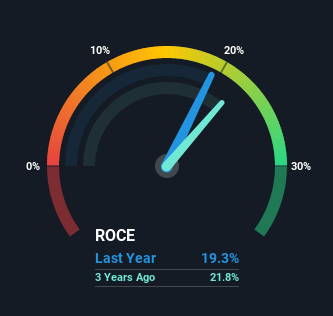Returns On Capital At T.V. Today Network (NSE:TVTODAY) Paint A Concerning Picture

There are a few key trends to look for if we want to identify the next multi-bagger. Firstly, we'll want to see a proven return on capital employed (ROCE) that is increasing, and secondly, an expanding base of capital employed. Put simply, these types of businesses are compounding machines, meaning they are continually reinvesting their earnings at ever-higher rates of return. Having said that, from a first glance at T.V. Today Network (NSE:TVTODAY) we aren't jumping out of our chairs at how returns are trending, but let's have a deeper look.
Understanding Return On Capital Employed (ROCE)
For those who don't know, ROCE is a measure of a company's yearly pre-tax profit (its return), relative to the capital employed in the business. To calculate this metric for T.V. Today Network, this is the formula:
Return on Capital Employed = Earnings Before Interest and Tax (EBIT) ÷ (Total Assets - Current Liabilities)
0.19 = ₹2.1b ÷ (₹13b - ₹2.0b) (Based on the trailing twelve months to December 2021).
Thus, T.V. Today Network has an ROCE of 19%. On its own, that's a standard return, however it's much better than the 11% generated by the Media industry.
View our latest analysis for T.V. Today Network

Above you can see how the current ROCE for T.V. Today Network compares to its prior returns on capital, but there's only so much you can tell from the past. If you'd like, you can check out the forecasts from the analysts covering T.V. Today Network here for free.
What Can We Tell From T.V. Today Network's ROCE Trend?
On the surface, the trend of ROCE at T.V. Today Network doesn't inspire confidence. To be more specific, ROCE has fallen from 25% over the last five years. Although, given both revenue and the amount of assets employed in the business have increased, it could suggest the company is investing in growth, and the extra capital has led to a short-term reduction in ROCE. If these investments prove successful, this can bode very well for long term stock performance.
In Conclusion...
Even though returns on capital have fallen in the short term, we find it promising that revenue and capital employed have both increased for T.V. Today Network. And the stock has followed suit returning a meaningful 52% to shareholders over the last five years. So while investors seem to be recognizing these promising trends, we would look further into this stock to make sure the other metrics justify the positive view.
One more thing to note, we've identified 1 warning sign with T.V. Today Network and understanding this should be part of your investment process.
While T.V. Today Network isn't earning the highest return, check out this free list of companies that are earning high returns on equity with solid balance sheets.
Valuation is complex, but we're here to simplify it.
Discover if T.V. Today Network might be undervalued or overvalued with our detailed analysis, featuring fair value estimates, potential risks, dividends, insider trades, and its financial condition.
Access Free AnalysisHave feedback on this article? Concerned about the content? Get in touch with us directly. Alternatively, email editorial-team (at) simplywallst.com.
This article by Simply Wall St is general in nature. We provide commentary based on historical data and analyst forecasts only using an unbiased methodology and our articles are not intended to be financial advice. It does not constitute a recommendation to buy or sell any stock, and does not take account of your objectives, or your financial situation. We aim to bring you long-term focused analysis driven by fundamental data. Note that our analysis may not factor in the latest price-sensitive company announcements or qualitative material. Simply Wall St has no position in any stocks mentioned.
About NSEI:TVTODAY
T.V. Today Network
Engages in the television programming and broadcasting activities in India, Canada, the United Arab Emirates, the United States, the United Kingdom, Qatar, South Africa, Maldives, and Seychelles.
Flawless balance sheet established dividend payer.
Market Insights
Community Narratives




